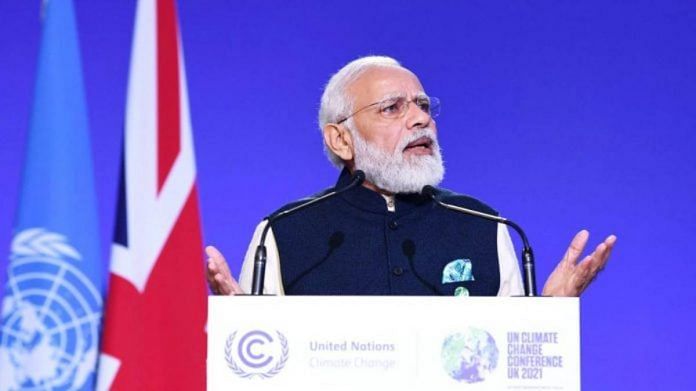New Delhi: Over 100 countries have promised to cut their methane emissions by at least 30 per cent by 2030, at the COP26 climate summit in Glasgow Tuesday.
Methane is a deadly greenhouse gas and the second biggest contributor to global warming, after carbon dioxide. Methane is over 80 times more potent than Co2 when observed over a 20 year period, but stays in the air for a much shorter time — around a decade. Carbon dioxide, on the other hand, can remain in the atmosphere for centuries.
The pledge to cut methane emissions was initiated by the US, under the leadership of President Joe Biden, and the European Commission in September, and was finally signed by 103 countries Tuesday.
“The short atmospheric lifetime of methane means that taking action now can rapidly reduce the rate of global warming and that readily available cost-effective methane emission measures have the potential to avoid over 0.2 degrees Celcius of warming by 2050,” states the pledge.
Also read: What India’s new climate goals mean, and why they are seen as ‘ambitious’
Where does methane come from
A large chunk of methane emitted — around 40 per cent, according to the International Energy Agency — comes from natural sources like wetlands and decomposing biomass.
But these emissions aren’t the problem. The remaining 60 per cent — emitted due to different human activities — has led to its accumulation in Earth’s atmosphere. Since it’s a greenhouse gas, it traps heat that would normally radiate from Earth’s back to the Sun, causing the atmosphere to warm up.
“The concentration of methane in the atmosphere is currently around two-and-half times greater than pre-industrial levels and is increasing steadily,” says the IEA.
One source of methane emission from human activities is the agricultural sector and livestock, which makes up over 30 per cent of all emissions. Other sources include landfills and waste, biomass, and use of fossil fuel.
Methane is also “the primary contributor to the formation of ground-level ozone, a hazardous air pollutant, and greenhouse gas, exposure to which causes 1 million premature deaths every year,” according to the United Nations Environment Programme.
Reductions in methane emissions are crucial to slowing down global warming and limiting it to 1.5 degrees Celsius above pre-industrial levels. The Intergovernmental Panel on Climate Change (IPCC) had in August warned that if global temperatures breach the 1.5 degree Celsius mark, extreme weather events due to climate change will become more intense and frequent. Since 1850, global temperatures have already risen by 1.1 per cent, and we are projected to reach 1.5 degrees Celcius above pre-industrial levels by 2040.
In this scenario, a 0.2 degree reduction in global temperatures could help considerably.
Also read: On climate change, China’s words and actions don’t match up
And India hasn’t signed the pledge
India is among the top 10 emitters of methane, but chose not to sign the Global Methane Pledge. Russia, China, and Iran — also among the top emitters — didn’t sign either.
In 2009, when India signed the Copenhagen Accord at the COP15, it had promised to reduce the greenhouse gas emissions intensity from all other sectors of the economy by 20-25 per cent by 2020, but had deliberately left out the agriculture sector which is a major contributor to methane emissions.
(Edited by Poulomi Banerjee)
Also read: India will reach net-zero emissions by 2070, PM Modi says at COP26 as he promises ‘panchamrit’



